AEG-Electrolux ERL6297XS10, ERL6296XX, ERL6297XX0, S65629SK0, S75628SK16 User Manual
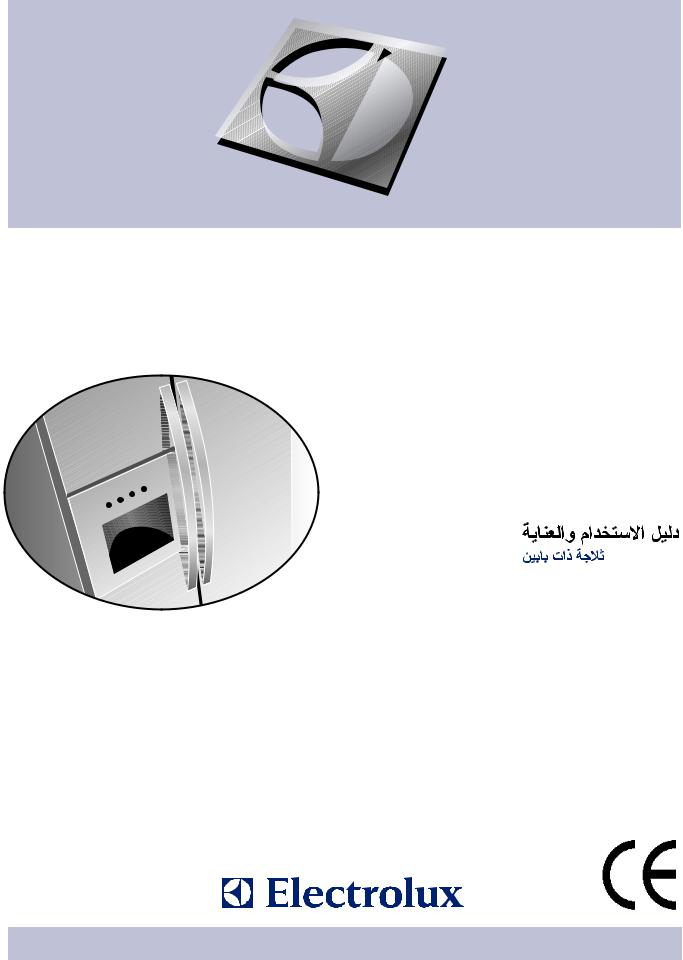
Use & Care Guide
S i d e - B y - S i d e R e f r i g e r a t o r
Guía de uso y cuidado
R e f r i g e ra d o r d e d o s p u e r t a s
Guide d’utilisation et d’entretien
R é f r i g é r a t e u r à c o m p a r t i m e n t s j u x t a p o s é s
Gebrauchs- & Pflegeanleitung
Doppeltür-Kühlschrank
ПдзгЯет чсЮузт кбй цспнфЯдбт
ШхгеЯп дэп ихсюн
Manual
Bredvidstående kyl/frysskåp
Gebruiksen onderhoudshandleiding
Side-by-side koel-/vrieskast
Käyttöja huolto-ohje
S i d e - B y - S i d e - j ä ä k a a p p i
Manuale d’uso e manutenzione
Frigorifero Side-By-Side
241595800 (0504)
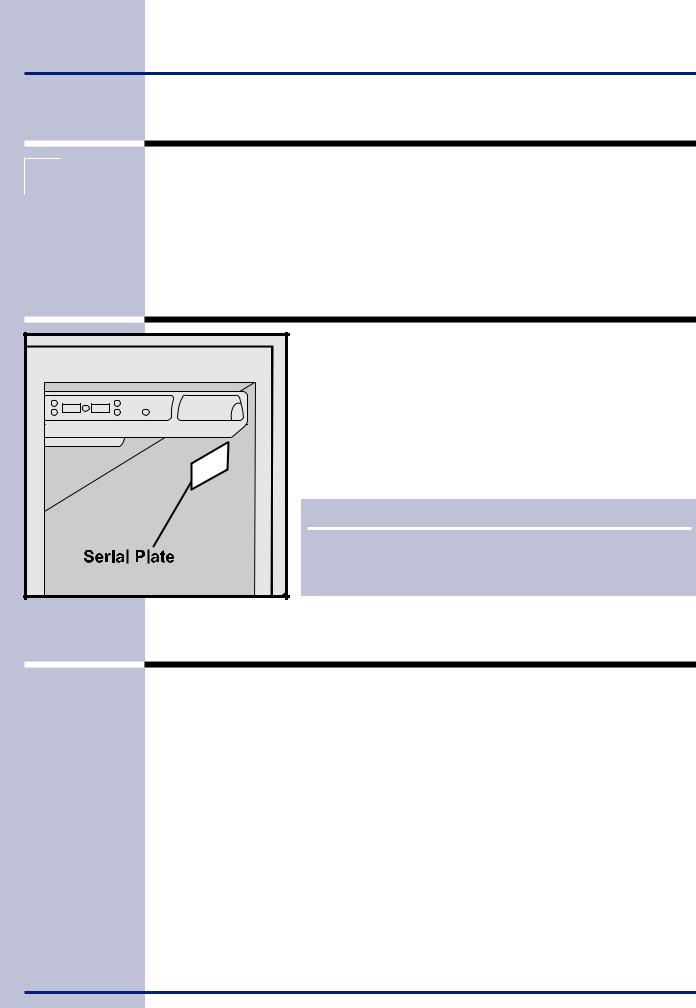
2 Finding Information
PLEASE READ AND SAVE THIS GUIDE
Attach your sales receipt to this page for future reference.
Thank you for choosing Electrolux. This Use & Care Guide is part of our commitment to customer satisfaction and product quality throughout the service life of your new refrigerator.
We view your purchase as the beginning of a relationship. To ensure our ability to continue serving you, please use this page to record key product information.
MAKE A RECORD FOR QUICK REFERENCE
________________________________________________
Purchase Date
________________________________________________
Electrolux Model Number
________________________________________________
Electrolux Serial Number (see picture for location)
NOTE
Registering your product with Electrolux enhances our ability to serve you. You can register by dropping your Product Registration Card in the mail.
TABLE OF CONTENTS |
|
Finding Information ............................................ |
2 |
Safety ................................................................... |
3 |
Installation ........................................................... |
5 |
Removing The Doors .......................................... |
6 |
Connecting The Water Supply ........................... |
8 |
Feature Overview ................................................ |
9 |
Controls & Settings .......................................... |
10 |
Storage Features ............................................... |
14 |
Automatic Ice & Water Dispenser ................... |
18 |
Changing The Filters ........................................ |
23 |
Storing Food & Saving Energy ........................ |
25 |
Normal Operating Sounds & Sights ............... |
27 |
Care & Cleaning ................................................ |
28 |
Solutions To Common Problems .................... |
31 |
©2004 Electrolux Home Products, Inc. All rights reserved. Printed in the USA
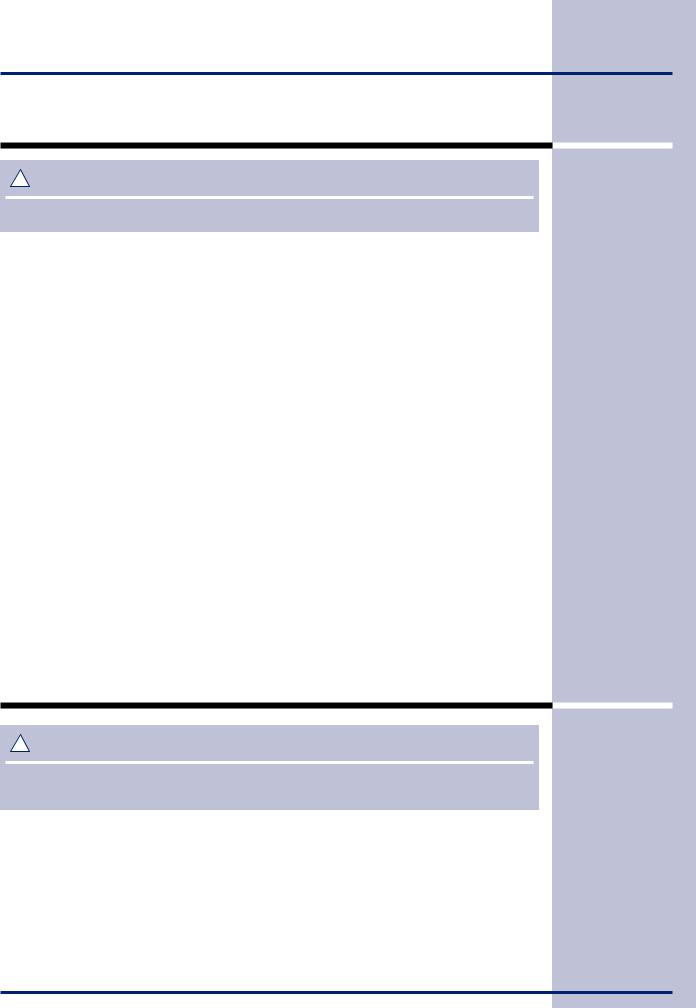
Safety 3
IMPORTANT SAFETY INSTRUCTIONS
! WARNING
Please read all safety instructions before using your new Electrolux refrigerator.
General Safety
•Do not store or use gasoline, or other flammable liquids, near this or any other appliance. Read product labels for warnings regarding flammability and other hazards.
•Do not operate the refrigerator in the presence of explosive fumes.
•Avoid contact with any moving parts of the automatic ice maker.
•Remove all staples from the carton to avoid cut injuries. Staples can also damage finishes if they come in contact with other appliances or furniture.
Child Safety
Packing Materials:
•Packing cartons covered with rugs, bedspreads, plastic sheets or stretch wrap may become airtight chambers and can quickly cause suffocation.
•Destroy or recycle the product’s carton, plastic bags, and any other exterior wrapping material immediately after the refrigerator is unpacked. Children should never play with these items.
Child Entrapment And Suffocation:
•These problems are not limited to the past. Whether junked, abandoned or temporarily stored (even for a few hours), unattended refrigerators and freezers are dangerous.
ELECTRICAL INFORMATION
! WARNING
You must follow these guidelines to ensure that your refrigerator’s safety mechanisms are operating correctly.
•If the power cord is damaged, it should be replaced by the manufacturer, service technician or a qualified person to prevent any risk.
•Never unplug the refrigerator by pulling on the power cord. Always grip the plug firmly, and pull straight out from the receptacle to prevent damaging the power cord.
•Unplug the refrigerator before cleaning and before replacing a light bulb to avoid electrical shock.

4Safety
•Performance may be affected if the voltage varies by 10% or more. Operating the refrigerator with insufficient power can damage the compressor. Such damage is not covered under your warranty.
•Do not plug the unit into an outlet controlled by a wall switch or pull cord to prevent the refrigerator from being turned off accidentally.
IMPORTANT
To turn off power to your refrigerator, unplug the power cord from the wall outlet.
Installation
LOCATION
•Choose a place that is near a grounded electrical outlet. Do Not use an extension cord or an adapter plug.
•If possible, place the refrigerator out of direct sunlight and away from the range, dishwasher or other heat sources.
•The refrigerator must be installed on a floor that is level and strong enough to support a fully loaded refrigerator.
•Consider water supply availability for models equipped with an automatic ice maker.
INSTALLATION
Installation Clearances
! CAUTION
Do Not install the refrigerator where the temperature will drop below 13°C (55°F) or rise above 43°C (110°F). The compressor will not be able to maintain proper temperatures inside the refrigerator. Do Not block the toe grille on the lower front of your refrigerator. Sufficient air circulation is essential for the proper operation of your refrigerator.
Allow the following clearances for ease of installation and plumbing and electrical connections:
Sides & Top |
10 mm (3/8 inch) |
Back |
25 mm (1 inch) |
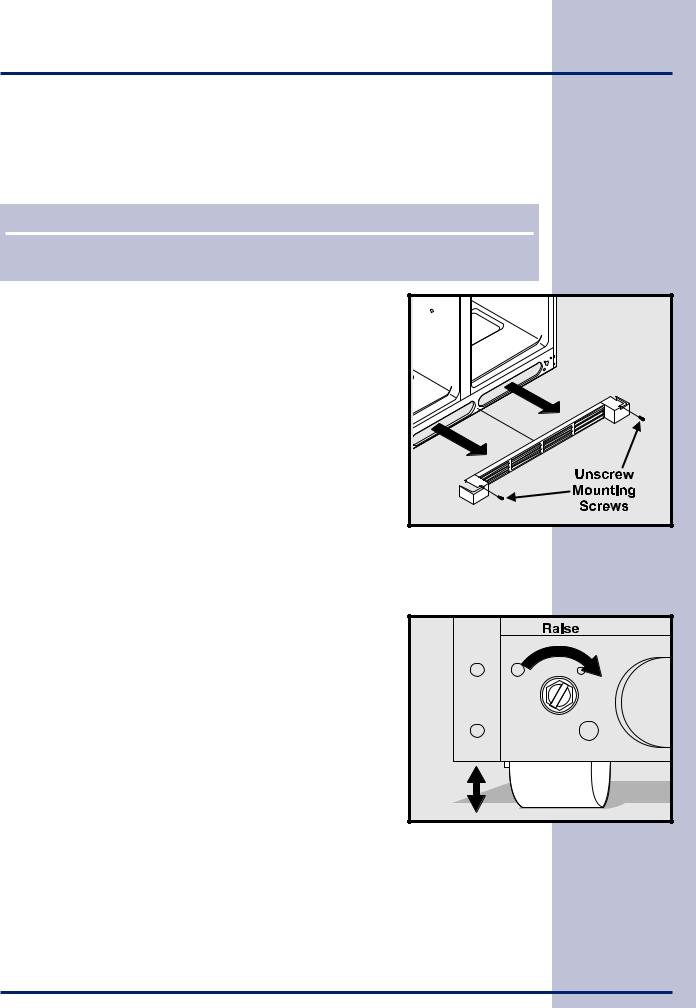
Installation 5
Door Opening
Your refrigerator should be positioned to allow easy access to a counter when removing food. For best use of drawers and freezer baskets, the refrigerator should be in a position where both the refrigerator and freezer doors can be fully opened.
NOTE
If your refrigerator is placed with the door hinge side against a wall, you may have to allow additional space so the door can be opened wider.
Removing And Replacing The Toe Grille
To remove the toe grille:
1Open freezer and refrigerator compartment doors.
2Remove the screw from each side of the toe grille.
3 Pull the toe grille forward and lift it off. Reverse these instructions to install the toe grille.
Leveling
All four corners of your refrigerator must rest firmly on a solid floor. Your refrigerator is equipped with adjustable front rollers to help level your unit. To ensure proper door seal and assist door closing, the refrigerator should be tilted 6 mm (1/4 inch), front to back.
To level your refrigerator:
1 Remove toe grille (see above) to access the front rollers.
2Adjust the rollers by turning each roller adjustment bolt with a wrench until the refrigerator is level and stable.
3 Check both doors to be sure seals touch cabinet on all four sides.
4 Replace the toe grille.
Tips:
•If the freezer door is higher than the refrigerator door, raise the right corner and/or lower the left corner until the doors align across the top of the cabinet.
•If the refrigerator door is higher than the freezer door, raise the left corner and/or lower the right corner until doors align across the top of the cabinet.
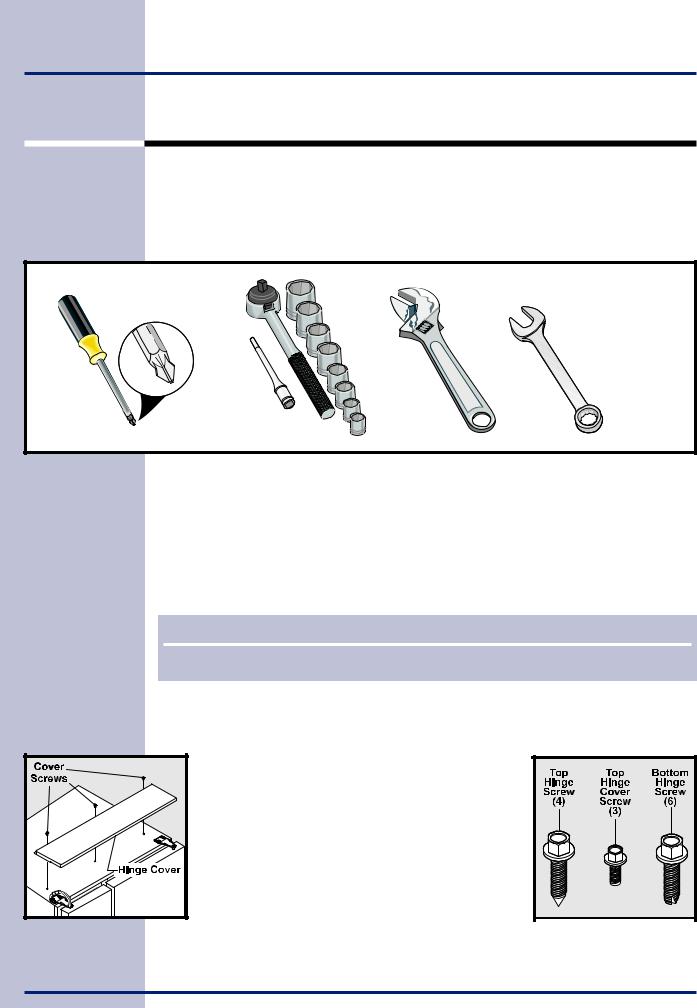
6 Removing The Doors
GETTING THROUGH NARROW SPACES
If your refrigerator will not fit through an entrance area, you can reduce its size by removing the doors. Check first by measuring the entrance.
Required Tools
You will need the following tools:
Tools Necessary:
AND |
OR |
OR |
|
|
Socket |
Adjustable |
3/8” Fixed |
Phillips™ Head |
Wrench Set |
Wrench |
Wrench |
To prepare for removing the doors:
1Make sure the electrical power cord is unplugged from the wall outlet.
2Open both doors and remove the toe grille.
3Remove any food from the door shelves.
4Close the doors.
NOTE
For more information on removing the toe grille, please refer to the Installation section.
To remove the top hinge cover:
1 Remove the three screws from the cover over the top door hinges.
2 Pull the cover forward about a half-inch and lift it off.
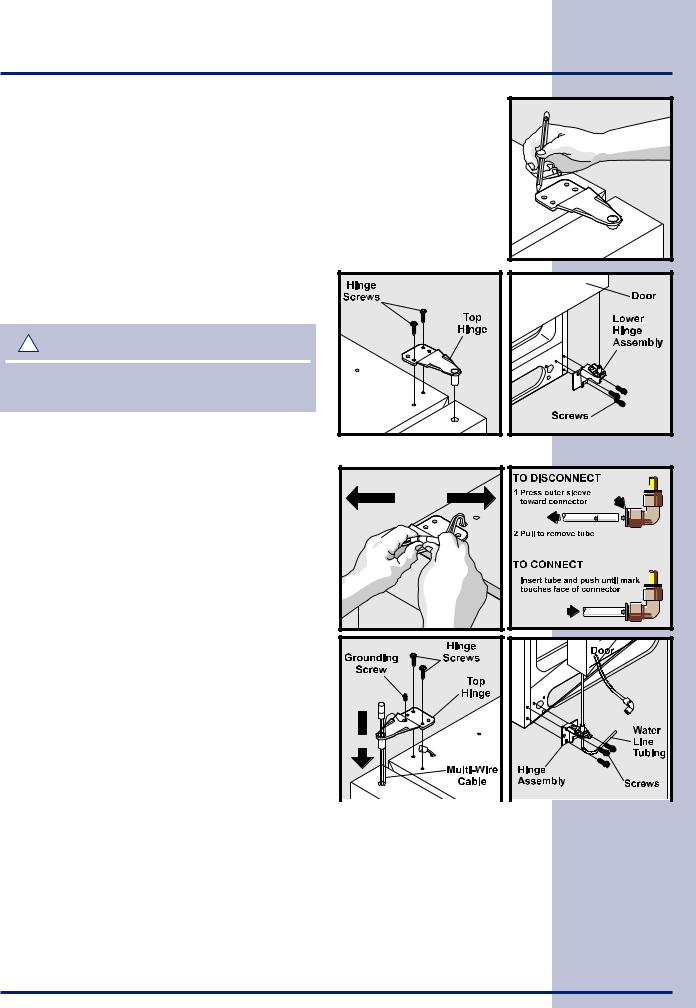
Removing The Doors 7
To remove the refrigerator door:
1Trace lightly around the door’s top hinge with a pencil. This makes reinstallation easier.
2Remove the two screws from the top hinge. Lift the door off of the
bottom hinge and and set it aside.
3 Remove the three bottom hinge screws and hinge if necessary.
To reinstall the refrigerator door, reverse the above steps. Once both doors are in place, also replace the
top hinge cover.
! CAUTION
Be sure doors are set aside in a secure position where they cannot fall and cause personal injury.
To remove the freezer door:
1 Detach the multi-wire cable connector located above the top hinge. Grasp both sides of the connector firmly and pull apart.
2 Trace lightly around the hinge with a pencil.
This makes reinstallation easier.
3 Detach the water tube from the connector located below the freezer door. The connector releases when you press its outer sleeve inward.
4 Remove the screws from the top hinge.
Leave the multi-wire cable inside the hinge.
Do not unscrew the ground wire that attaches the cable to the hinge. Lift the
door off of the bottom hinge.
5 Remove the three bottom hinge screws and
hinge if necessary.
6 Lay the door on its side to avoid damage to 
 the water tube extending from the bottom hinge.
the water tube extending from the bottom hinge.
To reinstall the freezer door, reverse the above steps. Once both doors are in place, also replace the top hinge cover.

8 Connecting The Water Supply
ABOUT YOUR REFRIGERATOR’S WATER SUPPLY
The automatic ice & water dispenser on your refrigerator requires a permanent water supply to function correctly. During installation, you (or a service professional) establish this water supply by connecting a copper tube from your household water system to a valve at the rear of the refrigerator.
! CAUTION
To avoid property damage:
•Use copper tubing for the water supply line (plastic tubing is more likely to leak). Manufacturer is not responsible for any damage if plastic tubing is used for supply line.
•Ensure water supply complies with local plumbing codes.
•For proper dispenser operation, recommended water supply pressure should fall between 1.4 and 6.9 bars. Excessive pressure may cause water filter to malfunction.
What you will need:
•Access to a cold water line with pressure of 1.4-6.9 bars.
•The water connector kit that comes with your refrigerator, which provides all materials for a water supply installation, including 7.6 m (25 feet) of copper tubing.
To connect the water supply to the rear of your refrigerator:
1 Ensure that the refrigerator is not plugged in.
2 Flush the supply line until water is clear by placing the end of the copper tube in a sink or bucket and opening the shut-off valve.
3 Unscrew the plastic cap from the water valve inlet at the rear of your refrigerator. Discard the cap.
4 Slide the brass compression nut, then the ferrule (sleeve) onto copper tube.
5 Push the copper tube into water valve inlet as far as it will go (6.5mm).
6 Slide the ferrule (sleeve) into valve and finger-tighten the compression nut onto valve. Tighten another half turn with a wrench. Do not over-tighten.
7 Secure the copper tube to your refrigerator’s rear panel with a steel clamp and screw (see illustration).

Connecting The Water Supply 9
8Coil the excess copper tubing (about 2½ turns) behind your refrigerator as shown. Arrange coiled tubing to avoid vibration or wear against other surfaces.
9Open water supply shut-off valve and tighten any connections that leak.
NOTE
After connecting the water supply, see information in this guide about priming an empty water supply system. Also read all topics in the “Automatic Ice & Water Dispenser” section to learn about normal operating procedures.
Feature Overview
NOTE
Features may vary according to model.
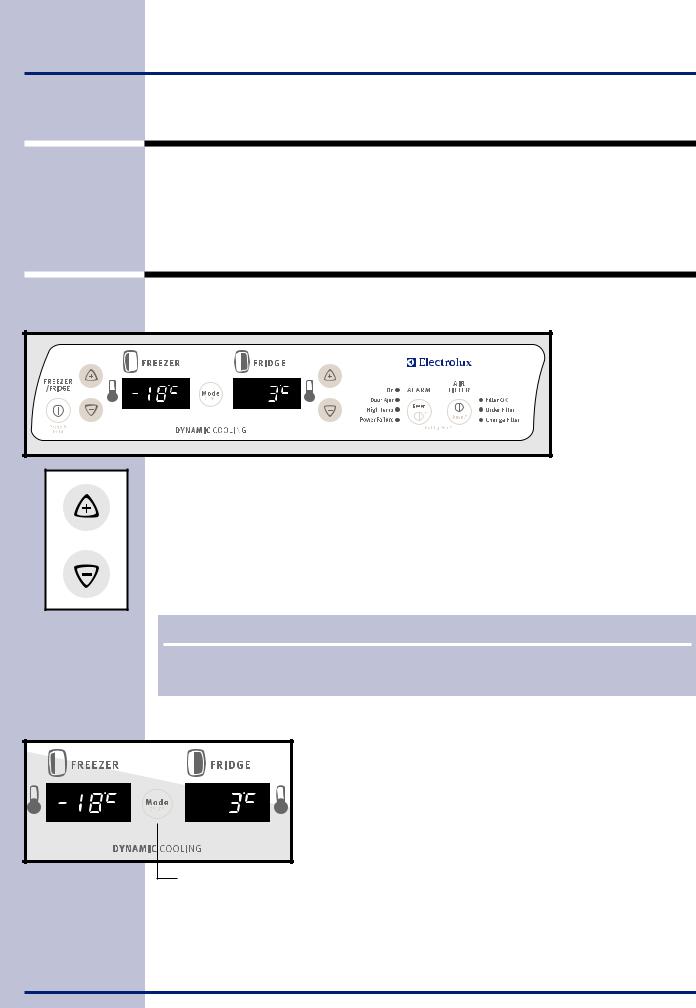
10 Controls & Settings
ALLOWING COOLING TIME BEFORE USE
To ensure reliable food storage, allow your refrigerator and freezer to operate with the doors closed for 8 to 12 hours before placing food inside. During this cooling period, you do not need to adjust the controls, which are preset at the factory.
SETTING COOLING TEMPERATURES
Your refrigerator comes with a state-of-the-art electronic digital control system. The system’s control panel is located at the top of the the fresh food compartment. The
two digital displays on the left half of the
control panel
indicate the current
temperatures of
your freezer and fresh food compartments.
To adjust the temperature to a higher or lower setting, press the Up or Down Arrow button closest to the display. The first time you press the button, the display shows the last setting you entered. Each press of the button after that increments the setting by one degree.
The display shows your new setting momentarily, then changes back to the current temperature. (Refer to following pages for more about temperature settings.)
NOTE
The advanced electronic control system in your refrigerator includes additional display modes that service professionals can use to rapidly diagnose performance issues.
Choosing Centigrade or Fahrenheit
Depending on which temperature standard you prefer to use, you can set your control panel to display in centigrade or fahrenheit. To change between fahrenheit and centigrade, press the Mode button (located between the two digital temperature displays).
Press to alternate between
Centigrade and Fahrenheit
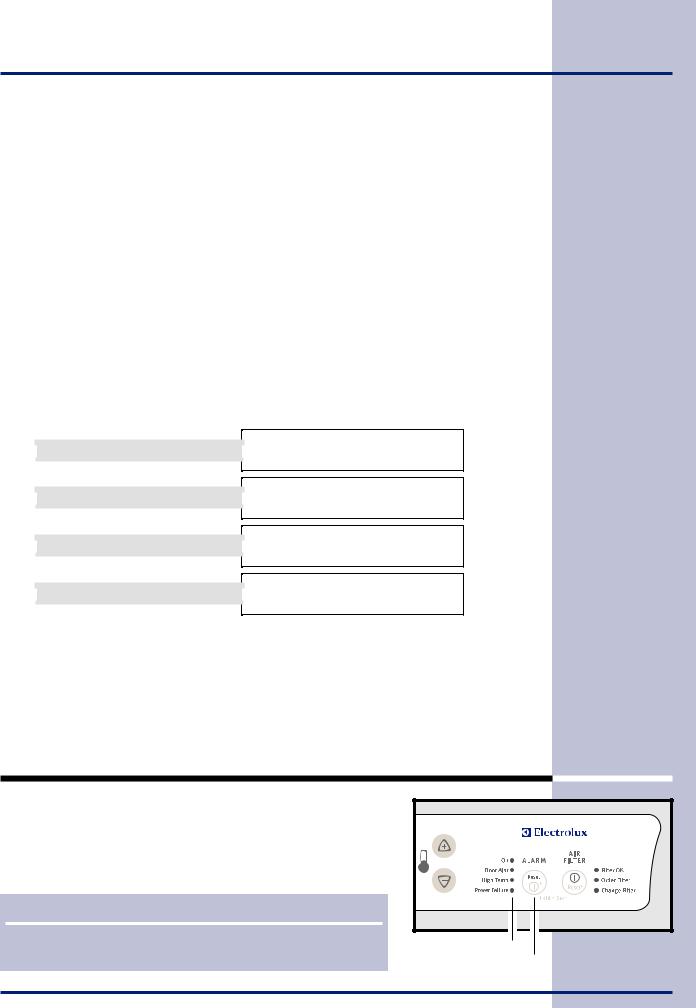
Controls & Settings 11
Making Temperature Adjustments
After running your refrigerator for 24 hours, you can adjust temperatures as needed. Make your adjustments small and gradual, allowing time for temperatures to change and stabilize. Refer to the following guidelines for temperature settings.
Temperature Control Range |
Freezer |
|
Fresh Food |
|
|||||
|
|
|
|
|
|
||||
|
|
|
|
Fahrenheit |
Centigrade |
|
Fahrenheit |
Centigrade |
|
|
|
|
|
|
|
|
|
|
|
|
|
Warmest |
|
6° |
-14° |
|
47° |
8° |
|
Warmer |
|
|
|
|
|
|
|
|
|
|
|
|
|
|
|
|
|
|
|
Factory Setting |
|
Midpoint |
|
0° |
-18° |
37° |
3° |
|
|
Colder |
|
|
|
|
|
|
|
|
|
Coldest |
|
-10° |
-23° |
|
33° |
1° |
|
||
|
|
|
|
|
|||||
|
|
|
|
|
|
|
|
|
|
Temperature Adjustment Guide
If Fresh Food compartment is too warm
If Fresh Food compartment is too cold
If Freezer compartment is too warm
If Freezer compartment is too cold
Adjust Fresh Food control one degree colder by pressing Down Arrow button.
Adjust Fresh Food control one degree warmer by pressing the Up Arrow button.
Adjust Freezer control one degree colder by pressing Down Arrow button.
Adjust Freezer control one degree warmer by pressing the Up Arrow button.
What To Do If The Temperature Displays Flash
If ever you you see both temperature displays continuously flashing, it may indicate that the control system has detected a performance problem. Call your Electrolux service representative, who can interpret the flashing message.
SYSTEM-MONITORING ALARMS
The electronic control system continuously monitors your refrigerator/freezer for temperature consistency, doors left ajar, and power failures. Variances from normal operating conditions are communicated by audible tones and a set of four status indicator lights.
NOTE
Each time you make settings on the control panel, a single audible tone acknowledges your input.
Indicator Lights
Alarm Reset Button
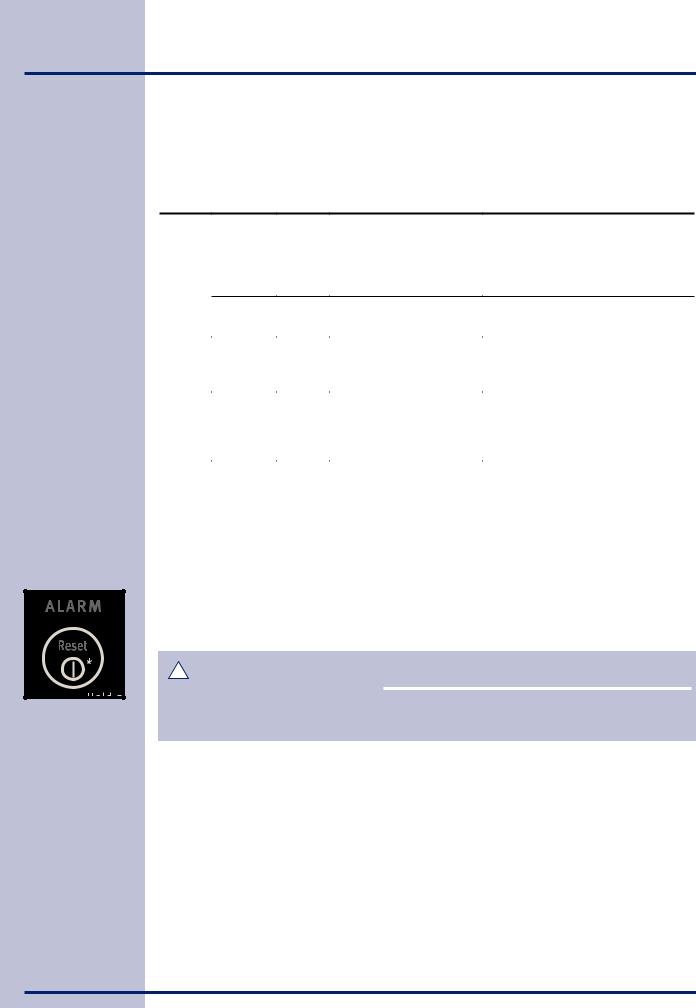
12 Controls & Settings
Responding to Alarms (Audible Tones & Indicator Lights)
Your refrigerator’s control system can convey the following information through audible tones and the alarm indicator lights.
Alarm |
Indicator |
Audible |
|
|
Name |
Light |
Tones |
Condition |
How To Respond |
On |
(light is |
Alarm system is not active |
|
off) |
while Freezer and Fresh |
|
|
Food compartments are |
|
|
cooling toward the current |
|
|
temperature settings. |
If Freezer and Fresh Food compartments do not match your temperature settings in three hours, expect the control system to signal other conditions.
|
Steady |
|
Alarm system is active. |
No response required. |
|
Green |
|
|
|
|
|
|
|
|
Door |
Flashing |
9 |
Freezer or Fresh Food |
Close door to disable and reset alarm. |
Ajar |
Green |
door has been open for |
|
|
|
|
|
over five minutes. |
|
|
|
|
|
|
High |
Flashing |
9 |
Freezer or Fresh Food |
Press Alarm Reset button to turn off |
Temp |
Amber |
compartment has been too |
alarm. |
|
|
|
|
warm (7.2° C or higher) for |
|
|
|
|
over an hour. |
|
|
|
|
|
|
Power |
Flashing |
|
A power outage was |
Press Alarm Reset button to turn off |
Failure |
Amber |
|
detected. |
alarm and again to reset. Check if the |
|
|
|
|
power failure lasted long enough to |
|
|
|
|
affect stored food temperatures. |
Using The Alarm Reset Button
You can disable or activate the alarm system by pressing and holding the Alarm Reset button for three seconds. Use it, for example, to turn off audible tones and/ or flashing indicator lights.
! CAUTION
The alarm system does not automatically reset if you disconnect and reconnect your refrigerator’s power cord. It can only be reactivated by pressing the Alarm Reset button.
Once you disable the alarm system, you must again press and hold the Alarm Reset button for three more seconds to reset (activate) the alarm system. The On indicator light remains off while the Freezer and Fresh Food compartments cool toward the current temperature settings. When temperature settings are reached, the On light displays green to indicate an active alarm system.
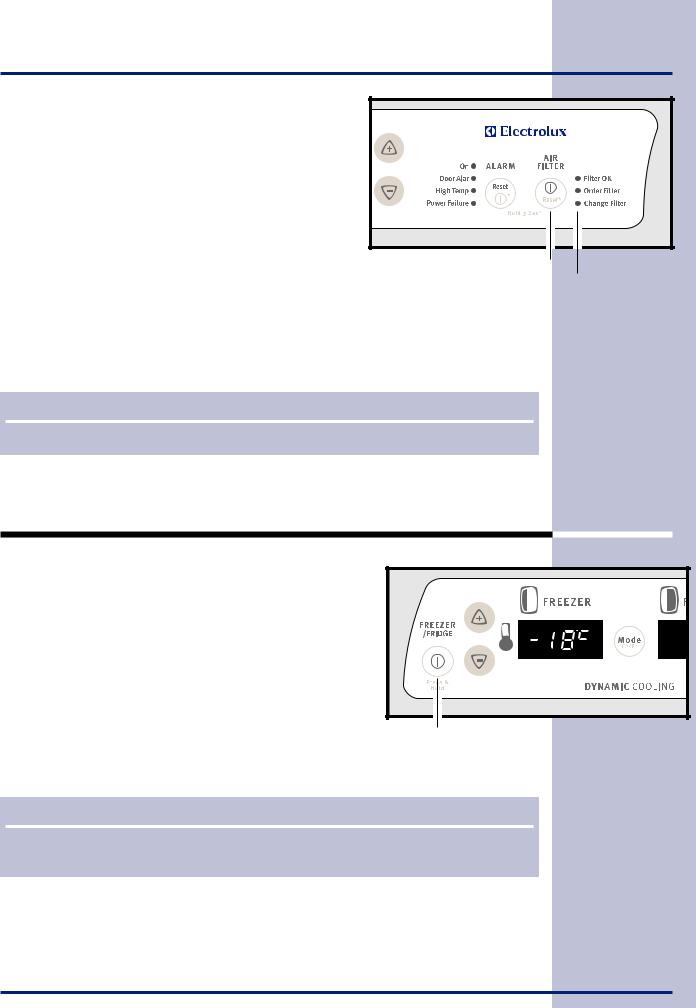
Controls & Settings 13
Checking the Air Filter Status
Your refrigerator’s fresh food air filter needs to be replaced from time to time. You can monitor the need for replacement by pressing and holding the Air Filter On/Off button for three seconds.
To check the air filter status:
1Press the Air Filter On/Off button. This activates a test cycle, and one of the three filter status lights displays, indicating one of the following:
Air Filter On/Off Button
Indicator Lights
Filter OK Air filter does not need changing.
Order Filter Air filter is about 80 percent used. Please order new one.
Change Filter Air filter is 100 percent used. Please change now.
2 Press the Air Filter On/Off button to turn off the status light.
NOTE
See the later section in this Use & Care Guide for instructions on replacing the air filter.
TURNING THE COOLING SYSTEM ON AND OFF
You can disable the cooling system in your refrigerator |
|
|
by pressing the On/Off button located on the left side of |
|
|
the temperature control panel. |
|
|
To ensure that you do not accidentally turn off the |
|
|
cooling system, the button does not work unless you |
|
|
press and hold it for three seconds. |
|
|
Once you disable the cooling system, all refrigeration to |
|
|
the freezer and fresh food compartments stops. |
|
|
To turn the cooling system back on, you must again |
Cooling System On/Off Button |
|
press and hold the On/Off button for three more |
||
|
||
seconds. |
|
IMPORTANT
The On/Off button only controls your refrigerator’s cooling system. Power to lights and other electrical components continues unless you unplug the power cord.
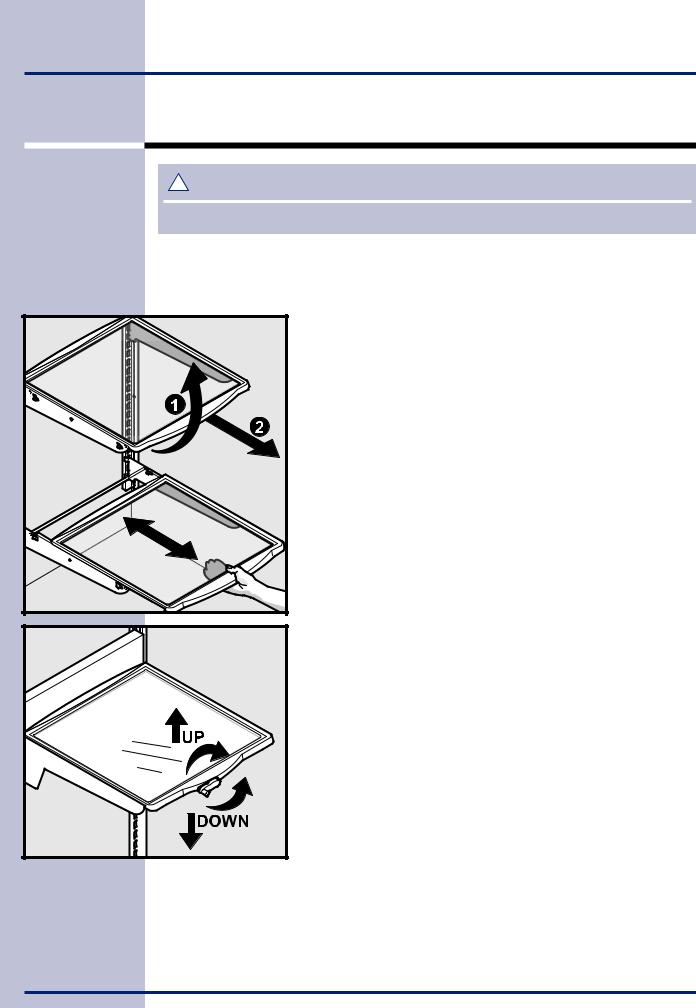
14 Storage Features
CANTILEVER SHELVES
! CAUTION
To avoid injury from breakage, handle tempered glass shelves carefully.
You can easily adjust shelf positions in the freezer and fresh food compartments to suit your needs. The shelves have mounting brackets, which attach to slotted supports at the rear of each compartment.
Cantilever |
Glass Shelf |
Cantilever |
Sliding Glass |
Shelf |
Cantilever Aspect |
Glass Shelf |
To change the position of a shelf:
1Before adjusting a shelf, remove all food.
2Lift the front edge up.
3Pull the shelf out.
4Replace by inserting the mounting bracket hooks into the desired support slots.
5Lower the shelf and lock into position.
Shelf Features
Your refrigerator includes SpillSafeTM glass shelves, which are designed to catch and hold accidental spills. These shelves slide out for easy access to food and faster cleaning.
Sliding shelves can be pulled forward as far as their built-in stops allow. Sliding shelves cannot be separated from their mounting brackets.
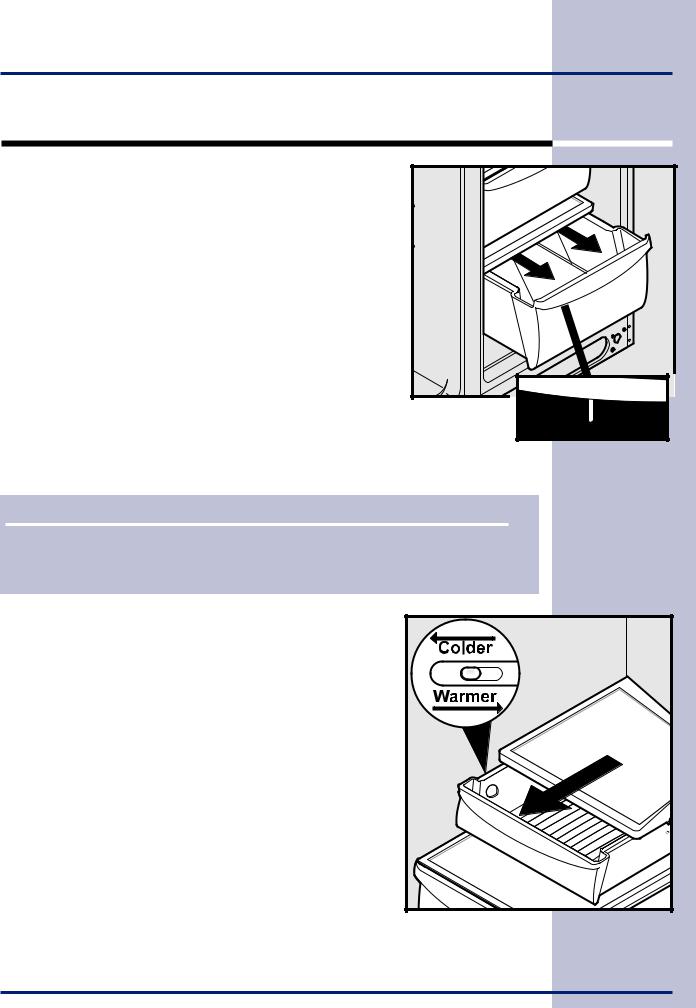
Storage Features 15
DRAWERS
Your refrigerator includes a variety of storage drawers. These drawers usually are located in fixed positions at the bottom of the fresh food compartment.
Crispers |
Crisper |
|
Crisper drawers are designed for storing fruits, vegetables, and other fresh produce. Before storing items in a crisper:
•Wash items in clear water and remove excess water.
•Wrap any items that have strong odors or high moisture content.
Crisper Humidity Control
Crisper drawers include a sliding control for adjusting the humidity inside the crisper. This feature can extend the life of certain fresh vegetables that keep longer in high humidity.
NOTE
Leafy vegetables keep best when stored with the Humidity Control set on Higher Humidity, or in a drawer without a Humidity Control. This keeps incoming air to a minimum and maintains maximum moisture content.
Meat Keeper
Some models are equipped with a meat keeper drawer for short term storage of bulk meat items. This drawer includes a sliding control for adjusting the temperature inside.
Any meat to be kept longer than two days should be frozen. If you store fruits or vegetables in this drawer, set it to a warmer temperature to prevent freezing.
Meat Keeper |
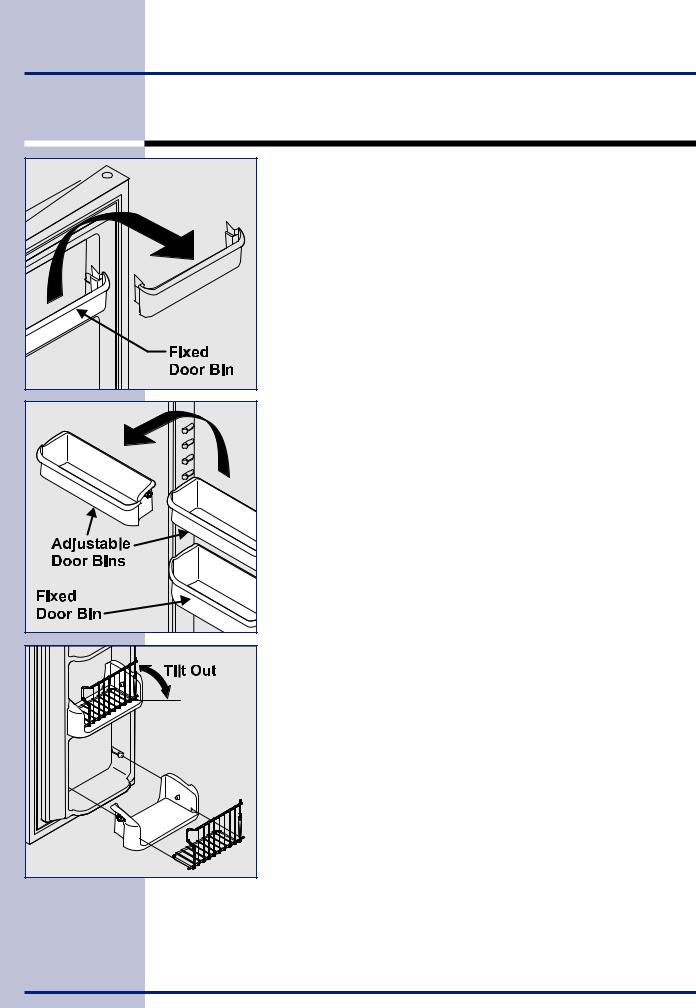
16 |
Storage Features |
|
|
DOORS |
|
|
Storage Bins |
|
|
The doors to your freezer and fresh food compartments use a |
|
|
system of modular storage bins. All of these bins are removable |
|
|
for easy cleaning. Some of them have fixed positions, while |
|
|
others can be adjusted to your needs. |
|
|
Door bins are ideal for storing jars, bottles, cans, and large drink |
|
|
containers. They also enable quick selection of frequently used |
|
|
items. |
|
|
To change the position of an adjustable door bin: |
|
|
1 |
Before adjusting a bin, remove all food. |
|
2 |
Grip the bin firmly with both hands and lift it upward. |
|
3 |
Remove the bin. |
|
4 |
Place the bin just above desired position. |
|
5 |
Lower the bin onto supports until locked in place. |
|
Door Bin With |
|
|
Tilt Shelf |
|
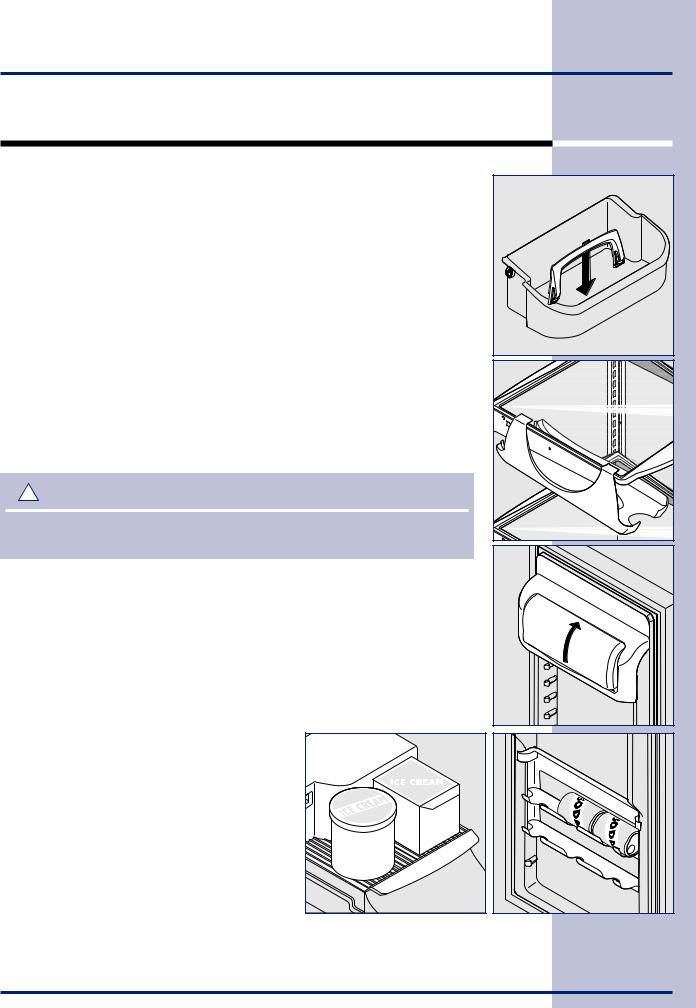
|
Storage Features |
17 |
|
ACCESSORIES |
|
|
|
Tall Bottle Retainer |
Tall Bottle |
|
|
The tall bottle retainer keeps tall containers in the bin from falling forward |
|
||
when opening or closing the refrigerator door. To install, snap the ends of |
Retainer |
|
|
|
|
||
the retainer over the edge of the retainer wall as shown in the illustration. |
|
|
|
Special Items Rack |
|
|
|
The innovative design of the special items rack allows you to store a six- |
|
|
|
pack of drink cans, a bottle of wine, a two-liter soft drink bottle, or a |
|
|
|
carton of eggs. To install, slide the special item rack onto the left side of |
|
|
|
any shelf as shown in the illustration. |
|
|
|
Dairy Compartment |
|
|
|
Use the dairy compartment, at the top of the fresh food compartment |
|
|
|
door, for short term storage of cheese, spreads, or butter. The dairy |
|
|
|
compartment, which includes a lift-up cover, is designed to be warmer |
|
|
|
than the open storage area to accommodate these types of food. |
|
|
|
! |
CAUTION |
|
|
|
|
|
|
To avoid errors in your refrigerator’s control system, do not remove the magnet |
Special |
||
Items Rack |
|||
that is mounted behind the dairy compartment. |
|
|
|
Can Rack |
|
|
|
The can rack allows you to efficiently and |
|
|
|
securely store up to six cans of beverage |
|
|
|
drink. |
|
|
|
Ice Cream Shelf |
|
|
|
The ice cream shelf attaches to the top of |
|
Dairy |
|
the ice dispenser container. It allows |
|
Compartment |
|
storage of both round and rectangular |
|
|
|
cartons of your favorite ice cream. |
|
Can Rack |
|
|
Ice Cream |
|
|
|
Shelf |
|
|
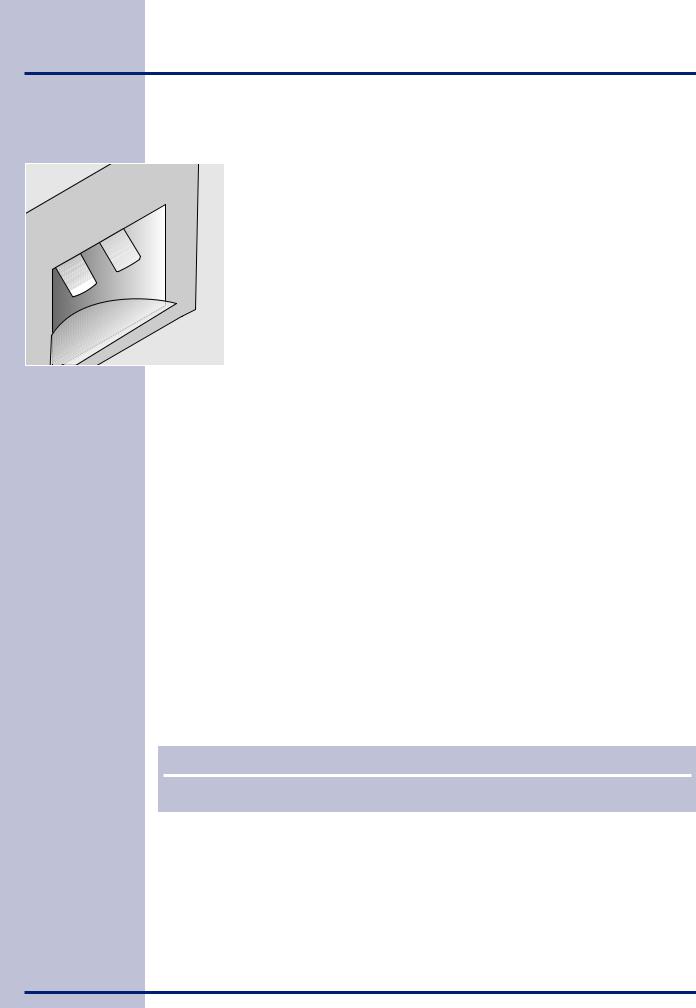
18 Automatic Ice & Water Dispenser
USING THE DISPENSER
Your automatic ice & water dispenser includes a control panel, a drinking glass bay, and two push-paddles for turning on the ice and water supplies.
Using the dispenser control panel is necessary for the ice dispenser but not the water dispenser. The control panel also includes options for lighting, filter monitoring, and increasing the rates of ice making and freezing.
Dispensing Ice
To operate the ice dispenser, press an option for crushed or cubed ice on the control panel. Press a drinking glass against the dispensing paddle (as far up as possible to catch all the ice). To stop, pull the glass away from the dispensing paddle.
See details for operating the dispenser controls on next page.
Dispensing Water
To operate the water dispenser, press a drinking glass against the dispensing paddle. To stop dispensing water, pull the glass away from the dispensing paddle.
The dispensed water is not cold. For colder water, first add crushed ice or cubes to your drinking glass.
Drip Tray
A drip tray located at the base of the dispenser bay catches small spills and allows them to evaporate. This drip tray is removable for easy cleaning.
NOTE
Please do not pour excess water and ice into the drip tray. It does not have a drain.
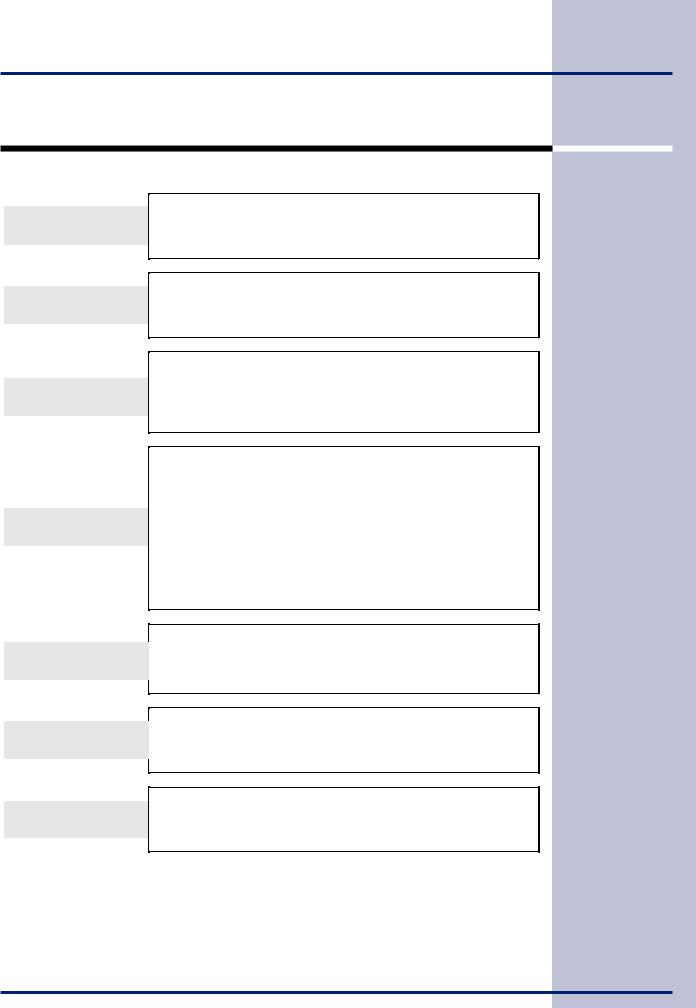
Automatic Ice & Water Dispenser 19
USING THE DISPENSER CONTROL PANEL
Cube Button
& Indicator Light
Crush Button
& Indicator Light
Light Button
& Indicator Light
Filter Status Button
& Indicator Light
Lock Button
& Indicator Light
Express Freeze Button
& Indicator Light
Express Ice Button
& Indicator Light
Press button to get cubed ice. Light displays blue.
Press glass against ice dispensing paddle, holding high up to catch all ice.
Press button to get crushed ice. Light displays blue.
Press glass against ice dispensing paddle, holding high up to catch all ice.
Press button to turn on dispenser light. Light displays blue. Press button again to turn off dispenser light.
Dispenser light also turns on automatically when ice and/or water is dispensed.
Light displays in one of three possible colors each time the dispenser is used to show status of water filter:
Green Water filter does not need changing.
Amber Water filter is about 80 percent used. Please order a new one.
Red Water filter is 100 percent used. Please change as soon as possible.
After replacing the water filter, reset the filter status by pressing and holding Filter Status button for 10-15 seconds.
The dispenser can be locked to prevent unwanted use.
To lock, press and hold button for 3-5 seconds. Light displays blue. To unlock, press and hold button for 3-5 seconds until light goes out.
Press and hold button for 3-5 seconds to activate faster rate for freezing food (preserving freshness). Light displays blue.
Press and hold button for 3-5 seconds again to deactivate.
Press and hold button for 3-5 seconds to increase ice production for special occasions, such as parties. Light displays blue.
Press and hold button for 3-5 seconds again to deactivate.
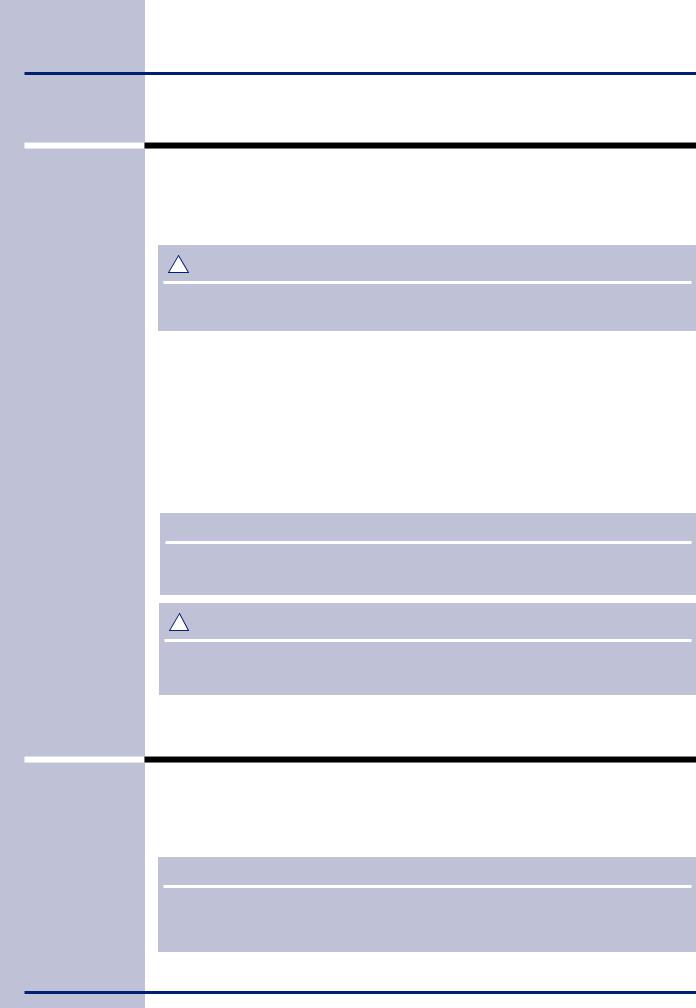
20 Automatic Ice & Water Dispenser
PRIMING THE WATER SUPPLY SYSTEM
Your refrigerator’s water supply system includes several tubing lines, an advanced water filter, a distribution valve bank, and a reserve tank to ensure ample supply to the ice and water dispenser at all times. This system needs to be completely filled with water when first connected to an external supply line.
! CAUTION
For proper dispenser operation, recommended water supply pressure should fall between between 1.4 and 6.9 bars. Excessive pressure may cause water filter to malfunction.
To prime the water supply system:
1Begin filling the tank by pressing and holding a drinking glass against the water dispenser paddle.
2Keep the glass in this position until water comes out of the dispenser. It may take about 1½ minutes.
3Continue dispensing water for about 3 minutes to flush the system and plumbing connections of any impurities (stopping to empty the glass as necessary).
NOTE
The water dispenser has a built-in device that shuts off the water flow after 3 minutes of continuous use. To reset this shutoff device, simply release the dispenser paddle.
! CAUTION
Pushing the dispensing paddle in for more than 4 minutes may cause the dispenser motor to overload and stop. The overload protector resets automatically after 3-4 minutes.
ICE DISPENSER OPERATION & CARE
The ice maker, ice bin, and dispenser feeding mechanism are located in the top of the freezer compartment. After the refrigerator is installed properly and has cooled for several hours, the ice maker can produce ice within 24 hours. It can completely fill an ice bin in about two days.
IMPORTANT
The ice maker is turned on at the factory so it can work as soon as you install your refrigerator. If you cannot connect a water supply, turn the ice maker’s On/Off switch to Off. Otherwise, the ice maker’s fill valve may be noisy when it attempts to operate without water.
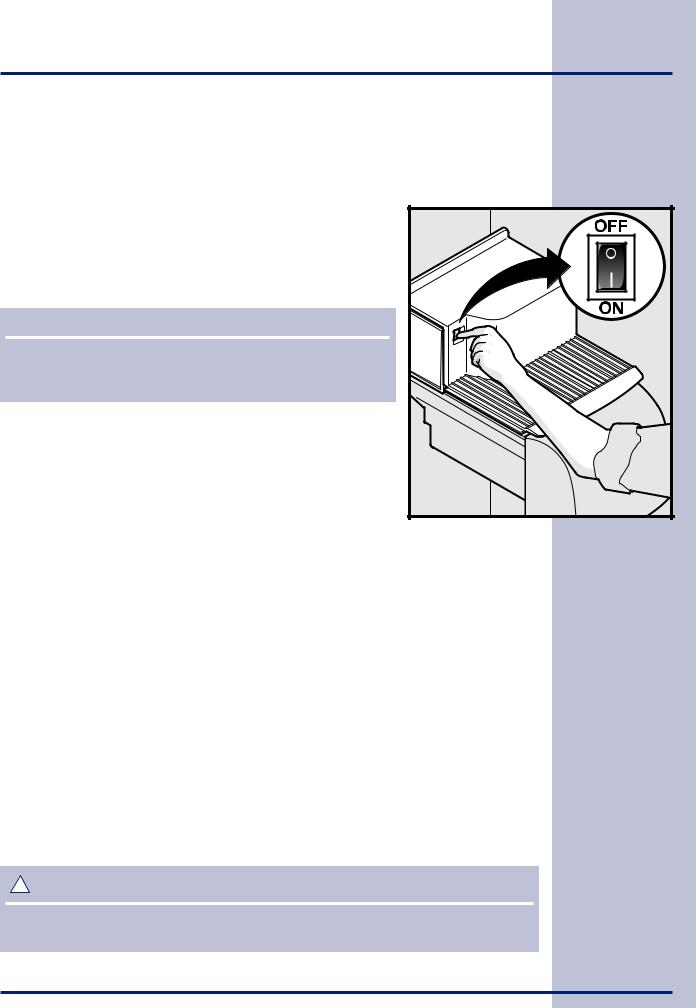
Automatic Ice & Water Dispenser 21
Using The Ice Dispenser After Installation
Before making ice for the first time, be sure to prime the water supply system as described earlier. Air in new plumbing lines can result in two or three empty ice maker cycles. Furthermore, if the system is not flushed, the first ice cubes may be discolored or have an odd flavor.
Turning The Ice Dispenser On And Off
Ice production is controlled by the ice maker’s On/Off power switch. Press the switch to the “O” position to turn it Off and press to the “I” position to turn it On.
NOTE
The ice maker also has a built-in wire signal arm, which automatically stops ice production when the ice bin is full. This signal arm should not be used to manually stop the ice maker.
Ice Dispenser Tips
•Ice cubes stored too long may develop an odd flavor. Empty the ice container as explained on the next page.
•Occasionally shake the ice container to keep ice separated.
•If your refrigerator is not connected to a water supply or the water supply is turned off, turn off the ice maker by pressing the On/Off switch.
•If you need a large quantity of ice at one time, it is best to get cubes directly from the ice container.
•The following sounds are normal when the ice maker is operating:
•Motor running
•Ice dropping into ice container
•Water valve opening or closing
•Ice loosening from tray
•Running water
•Turn off the ice maker when cleaning the freezer and during vacations.
•If you turn off the ice maker for a long period of time, you should also turn off the water supply valve.
!CAUTION
Chemicals from a malfunctioning water softener can damage the ice maker. If the water supply to your refrigerator is softened, be sure the softener is maintained to work properly.
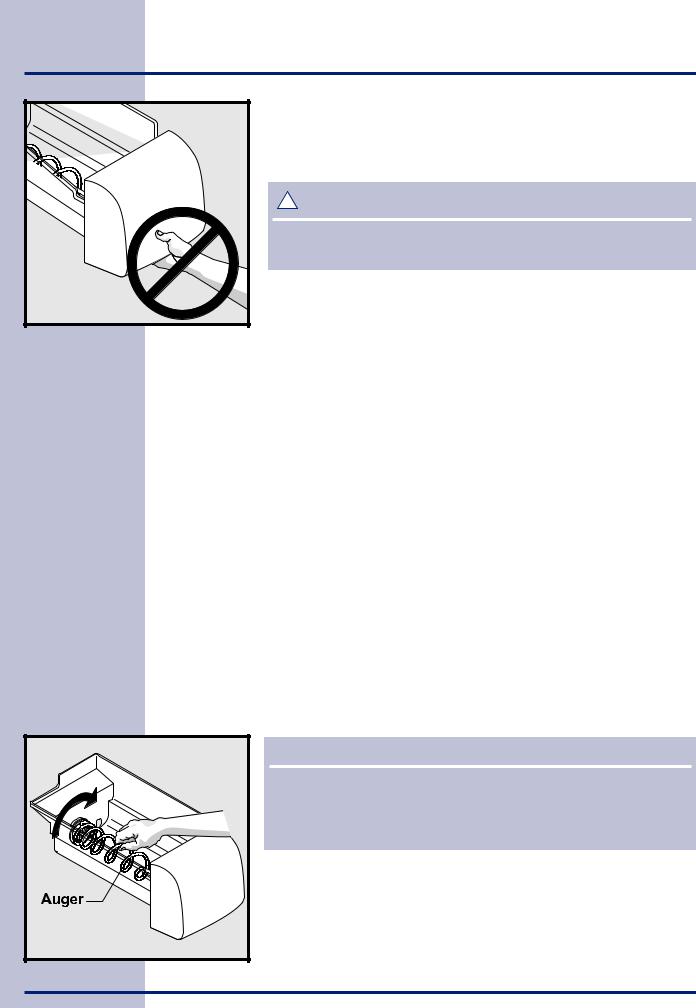
22 |
Automatic Ice & Water Dispenser |
|
|
Cleaning The Ice Dispenser |
|
|
Clean the ice maker and ice bin at regular intervals, particularly |
|
|
before you take a vacation or move. |
|
|
! |
CAUTION |
|
|
|
|
When removing the ice bin, do not grip the ice chute (beneath the front of |
|
|
the bin) as a handle. Surfaces in the ice chute may be sharp. |
|
To clean the ice dispenser:
1Turn off ice production by pressing the ice maker’s Off/On switch.
2Remove the ice bin by lifting up and out.
3Empty and carefully clean the ice bin with mild detergent. Rinse with clear water. Do not use harsh or abrasive cleaners.
4Allow the ice bin to dry completely before replacing in the freezer.
5Remove ice chips and clean the ice bin shelf and the freezer door chute.
6Replace the ice bin. Press the ice maker’s Off/On switch to resume ice production.
Remove and empty the ice storage bin if:
•An extended power failure (one hour or longer) causes ice cubes in the ice storage bin to melt and freeze together, jamming the dispenser mechanism.
•You do not use the ice dispenser frequently. Ice cubes will freeze together in the bin, jamming the dispenser mechanism.
Remove the ice storage bin and shake to loosen the cubes or clean as explained above. Never use an ice pick or similar sharp instrument to break up the ice. This could damage the ice storage bin and dispenser mechanism.
IMPORTANT
When removing the ice bin, avoid rotating the auger inside the bin. The auger must align with its drive mechanism when the bin is replaced. If you accidentally move the auger, realign by making quarter turns until the ice bin fits back in place.

Changing The Filters |
23 |
|
LOCATING THE FILTERS |
|
|
Your refrigerator is equipped with separate water and air |
|
|
filtering systems. The water filter system filters all |
|
|
dispensed drinking water, as well as the water used to |
Water Filter |
|
produce ice. The air filter removes odors and impurities |
|
|
from the refrigerator compartment. |
|
|
Water Filter |
|
|
The water filter is located at the top of the fresh food |
|
|
compartment, next to the electronic control system panel. |
|
|
See the earlier section in this manual for more information |
|
|
about when to replace the filter. |
Air Filter |
|
Air Filter |
|
|
The air filter is located inside the refrigerator compartment |
|
|
at the top rear corner. See the earlier section in this manual |
|
|
for more information about when to replace the filter. |
|
|
REPLACING THE AIR FILTER
In general, you should change the air filter every six months to ensure optimal filtering of refrigerator odors. You may want to adjust this time period depending on the types and amounts of food you typically store in your
refrigerator. To replace your air filter:
1 Push the plastic bubble tab located on the side of the air filter housing. The hinged bottom half drops open.
2Remove the old filter and discard it.
3Unpackage the new filter and place it inside the hinged bottom half of the housing.
4Push the hinged bottom half upward until the tab snaps
into closed position.
5 Press and hold the Filter Reset button on the electronic control panel for 3 seconds. When the Filter OK light comes on, the status has been reset.
6 Press and hold the Filter Reset button for 3 seconds again to turn off the filter status system.
NOTE
The electronic control panel, located at the top of the refrigerator compartment, includes controls to monitor the status of your air filter. See the previous section for more information about these controls.
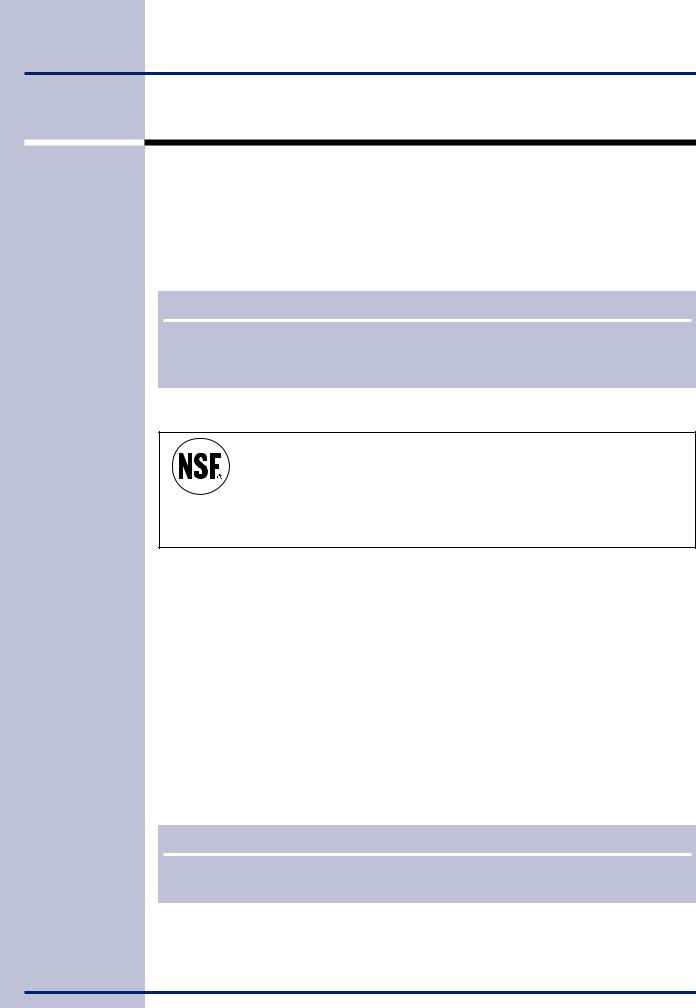
24 Changing The Filters
REPLACING THE WATER FILTER
In general, you should change the water filter every six to nine months to ensure highest possible water quality. The Filter Status light on the dispenser control panel prompts you to replace the filter after 1514 liters of water has flowed through the system.
If your refrigerator has not been used for a period of time (during moving for example), change the filter before reinstalling the refrigerator.
NOTE
The ice and water system can also operate without filtration if you use a bypass in place
of the water filter cartridge. Please contact the Electrolux Customer Care Center to order the bypass component (Part No. 240396701).
More About Your Advanced Water Filter
The pure advantageTM or pure advantageplus Ice & Water Filter System is tested and certified by NSF International, the nationally
respected, not-for-profit certification organization for public health safety. The filter system is tested and certified to ANSI/NSF
Standards 42 and 53. See the performance data sheet that came with your product for detailed specifications.
This system should not be used on water that is microbiologically unsafe or with water of unknown quality unless the water has been adequately disinfected before or after traveling through the filtration system. NSF Test & Certification Results:
•Rated Capacity - 1514 liters
•Rated service flow - 1.9 liters per minute
•Maximum Rated Pressure - 6.9 bars
•Maximum Operating Temp. - 37.8° C
To replace the water filter:
It is not necessary to turn the water supply off to change the filter. Be ready to wipe up any small amounts of water released during the filter replacement. The bottom of the filter housing includes two small water drainage holes, so be sure to remove any stored food from the top shelf.
NOTE
The o-rings on a new water filter are lubricated. To ensure a good seal, please do not remove this lubricant.
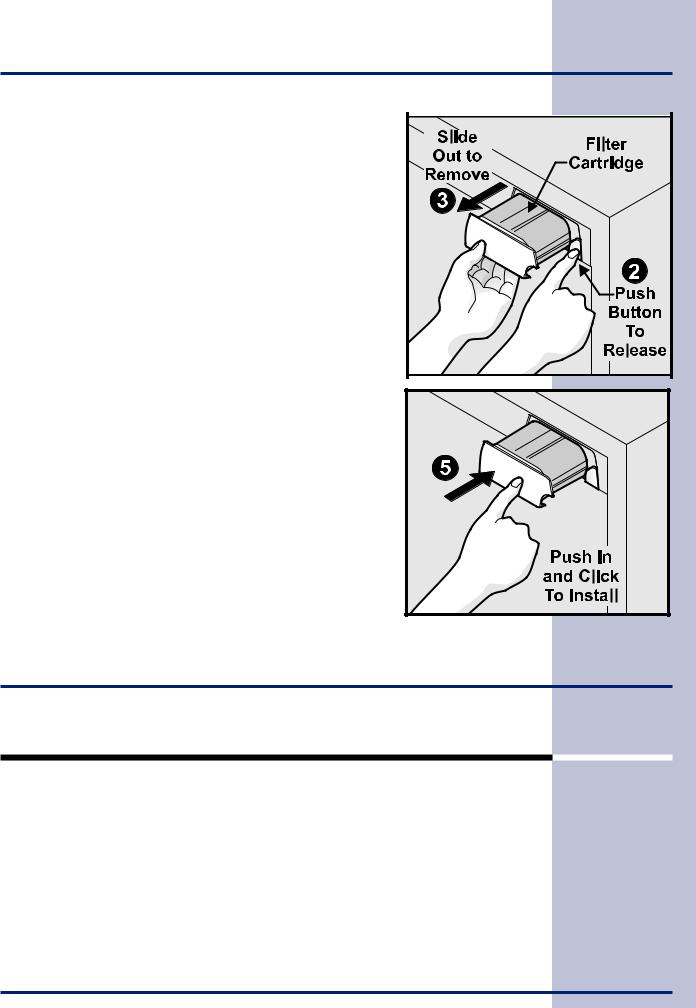
|
Changing The Filters |
25 |
1 |
Turn Off the ice maker power switch (see the earlier |
|
|
section for more about turning off the ice maker). |
|
2 |
Push the filter release button to the right of the |
|
|
cartridge to disconnect it. |
|
3 |
Slide the old filter cartridge straight out of the housing |
|
|
and discard it. |
|
4 |
Unpackage the new filter cartridge and slide it gently |
|
|
into the filter housing until it stops against the snap-in |
|
|
connector at the back of the housing. |
|
5 |
Push firmly until the cartridge snaps into place. |
|
|
When fully engaged, the front of the filter cartridge |
|
|
should be flush with the filter release button. |
|
6 |
Turn On the ice maker power switch (see page 23 for |
|
|
more about turning on the ice maker). |
|
7Press a drinking glass against the water dispenser while checking for any leaks at the filter housing. Any spurts and sputters that occur as the system purges air out of the dispenser system are normal.
8 After filling one glass of water, continue flushing the system for about three minutes.
9Press and hold the Filter Status button on the Ice & Water Dispenser control panel for 3 seconds. The light flashes red, amber, and green to indicate the
Filter Status has been reset.
Storing Food & Saving Energy
IDEAS FOR STORING FOODS
Fresh Food Storage
•Keep the fresh food compartment between 1.1° C and 4.4° C with an optimum temperature of 2.8° C (see the earlier section for more information about temperature settings).
•Avoid overcrowding the refrigerator shelves, which reduces air circulation and causes uneven cooling.
Fruits and Vegetables
•Store fruits and vegetables in crisper drawers, where trapped moisture helps preserve food quality for longer time periods.

26 Storing Food & Saving Energy
Meat
•Wrap raw meat and poultry securely so leakage and contamination of other foods or surfaces does not occur.
•Use the meat keeper drawer for short term storage. Any meat to be kept longer than two days should be frozen.
Frozen Food Storage
•Keep the freezer compartment at -18° C or lower (see the earlier section for more information about temperature settings).
•A freezer operates most efficiently when it is at least 2/3 full.
Packaging Foods for Freezing
•To minimize food dehydration and quality deterioration, use aluminum foil, freezer wrap, freezer bags or airtight containers. Force as much air out of the packages as possible and seal them tightly. Trapped air can cause food to dry out, change color, and develop an off-flavor (freezer burn).
•Wrap fresh meats and poultry with suitable freezer wrap prior to freezing.
•Do not refreeze meat that has completely thawed.
Loading the Freezer
•Avoid adding too much warm food to the freezer at one time. This overloads the freezer, slows freezing, and can raise the temperature of frozen foods.
•Leave a space between packages, so cold air can circulate freely, allowing food to freeze as quickly as possible.
•Avoid storing hard-to-freeze foods, such as ice cream and orange juice, on the freezer door shelves.
IDEAS FOR SAVING ENERGY
Installation
• Locate the refrigerator in the coolest part of the room, out of direct sunlight, and away from heating ducts or registers. Do not place the refrigerator next to heat-producing appliances such as a range, oven, or dishwasher. If this is not possible, a section of cabinetry or an added layer of insulation between the two appliances will help the refrigerator operate more efficiently.
• Level the refrigerator so that the doors close tightly.
Food Storage
•Avoid overcrowding the refrigerator or blocking cold air vents. Doing so causes the refrigerator to run longer and use more energy.
•Cover foods and wipe containers dry before placing them in the refrigerator. This cuts down on moisture build-up inside the unit.
•Organize the refrigerator to reduce door openings. Remove as many items as needed at one time and close the door as soon as possible.
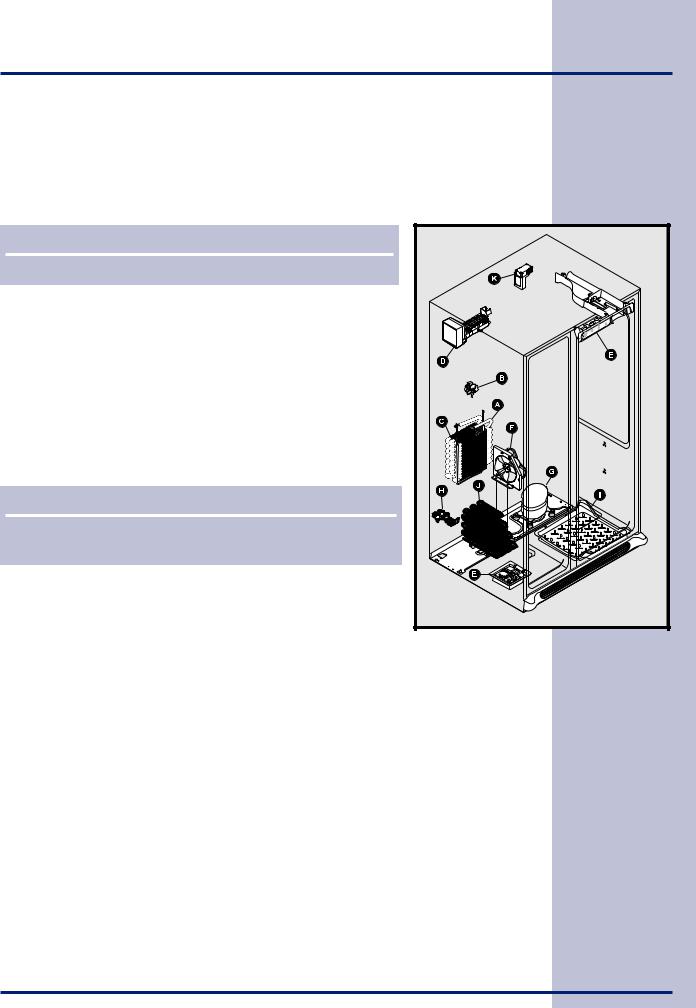
Normal Operating Sounds & Sights 27
UNDERSTANDING THE SOUNDS YOU MAY HEAR
Your new high-efficiency refrigerator may introduce unfamiliar sounds. These sounds normally indicate your refrigerator is operating correctly. Some surfaces on floors, walls, and kitchen cabinets may make these sounds more noticeable.
NOTE
Energy efficient foam in your refrigerator is not a sound insulator.
Following is a list of major components in your refrigerator and the sounds they can cause:
A Evaporator Refrigerant through the evaporator may create a boiling or gurgling sound.
B Evaporator Fan You may hear air being forced through the refrigerator by the evaporator fan.
C Defrost Heater During defrost cycles, water dripping onto the defrost heater may cause a hissing or sizzling sound. After defrosting, a popping sound may occur.
IMPORTANT
During automatic defrost cycle, a red glow in the back wall vents of your freezer compartment is normal.
D Automatic Ice Maker When ice has been produced, you will hear ice cubes falling into the ice bin.
ECold Control & Automatic Defrost Control These parts
can produce a snapping or clicking sound when turning the cooling system on and off.
FCondenser Fan You may hear air being forced through the condenser.
GCompressor Modern, high-efficiency compressors run much faster than in the past. The compressor may have a high-pitched hum or pulsating sound.
HWater Valve Makes a buzzing sound each time it opens to fill the ice maker.
IDrain Pan (not removable) You may hear water dripping into the drain pan during the defrost cycle.
JCondenser May create minimal sounds from forced air.
KMotorized Damper May produce a light humming during operation.

28 Care & Cleaning
PROTECTING YOUR INVESTMENT
Keeping your refrigerator clean maintains appearance and prevents odor build-up. Wipe up any spills immediately and clean the freezer and fresh food compartments at least twice a year. When cleaning, take the following precautions:
•Never use metallic scouring pads, brushes, abrasive cleaners or strong alkaline solutions on any surface.
•Do not wash any removable parts in a dishwasher.
•Always unplug the electrical power cord from the wall outlet before cleaning.
NOTE
If you set your temperature controls to turn off cooling, power to lights and other electrical components continues until you unplug the power cord from the wall outlet.
•Remove adhesive labels by hand. Do not use razor blades or other sharp instruments which can scratch the appliance surface.
•Do not remove the serial plate.
Refer to the guide on the next page for details on caring and cleaning specific areas of your refrigerator.
!CAUTION
•Pull the refrigerator straight out to move it. Shifting it from side to side may damage flooring. Be careful not to move the refrigerator beyond the plumbing connections.
•Damp objects stick to cold metal surfaces. Do not touch refrigerated surfaces with wet or damp hands.
IMPORTANT
If you store or move your refrigerator in freezing temperatures, be sure to completely drain the water supply system. Failure to do so could result in water leaks when the refrigerator is put back into service. Contact a service representative to perform this operation.
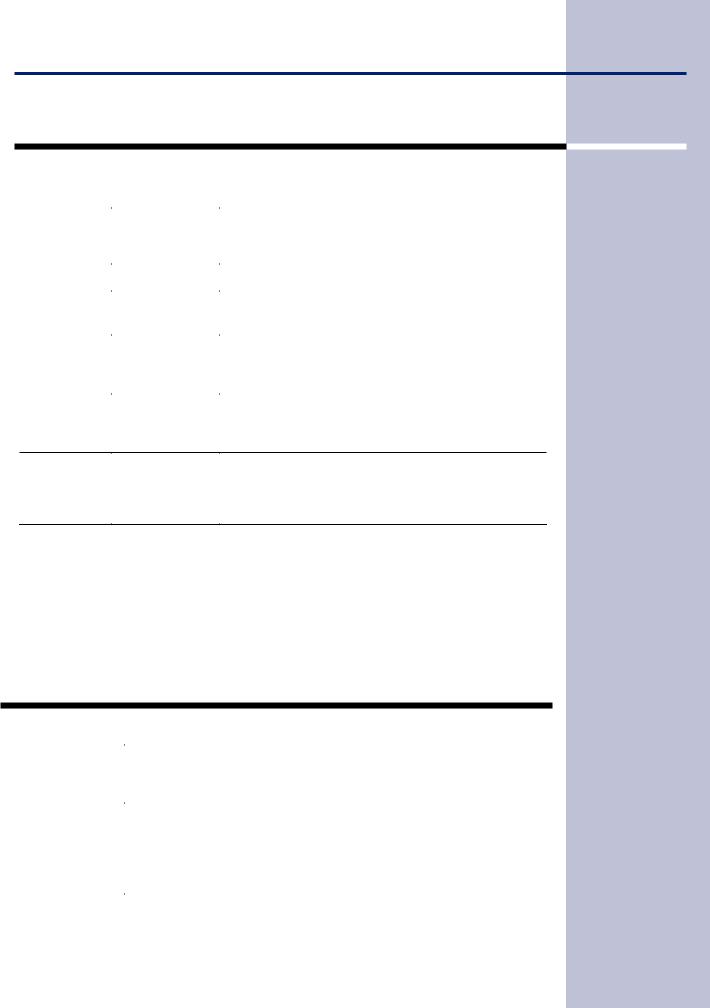
Care & Cleaning 29
CARE & CLEANING TIPS
Part |
Cleaning Agents |
Tips and Precautions |
Interior & Door |
• Soap and water |
• Use 2 tablespoons of baking soda in 946 ml of warm water. |
Liners |
• Baking soda and |
• Be sure to wring excess water out of sponge or cloth before cleaning around |
|
water |
controls, light bulb or any electrical part. |
|
|
|
Door Gaskets |
• Soap and water |
• Wipe gaskets with a clean soft cloth. |
|
|
|
Drawers & Bins |
• Soap and water |
• Use a soft cloth to clean drawer runners and tracks. |
|
|
• Do not wash any removable items (bins, drawers, etc.) in dishwasher. |
|
|
|
Glass Shelves |
• Soap and water |
• Allow glass to warm to room temperature before immersing in warm water. |
|
• Glass cleaner |
|
|
• Mild liquid sprays |
|
|
|
|
Toe Grille |
• Soap and water |
• Vacuum dust from front of toe grille. |
|
• Mild liquid sprays |
• Remove toe grille. |
|
• Vacuum attachment |
• Vacuum backside and wipe with sudsy cloth or sponge. Rinse and dry. |
Exterior & Handles • Soap and water
• Non Abrasive Glass Cleaner
•Do not use commercial household cleaners, ammonia, or alcohol to clean handles.
•Use a soft cloth to clean smooth handles.
•Do not use a dry cloth to clean smooth doors.
Exterior & Handles |
• Soap and water |
(Stainless Steel |
• Ammonia |
Models Only) |
• Stainless Steel |
|
Cleaners |
•Clean stainless steel front and handles with non-abrasive soapy water and a dishcloth. Rinse with clean water and a soft cloth.
•Wipe stubborn spots with an ammonia-soaked paper towel, and rinse. Use a non-abrasive stainless steel cleaner. These cleaners can be purchased at most home improvement or major department stores. Always follow manufacturer's instruction.
•NOTE: Always, clean, wipe and dry with grain to prevent scratching.
•Wash the rest of the cabinet with warm water and mild liquid detergent. Rinse well, and wipe dry with a clean soft cloth.
VACATION & MOVING TIPS
|
Occasion |
Tips |
|
|
Short Vacations |
• Leave refrigerator operating during vacations of 3 weeks or less. |
|
|
|
• Use all perishable items from refrigerator compartment. |
|
|
|
• Turn automatic ice maker off and empty ice bucket, even if you will only be gone for a few days. |
|
|
|
|
|
|
Long Vacations |
• Remove all food and ice if you will be gone one month or more. |
|
|
|
• Turn the cooling system off and disconnect power cord. |
|
|
|
• Turn off automatic ice maker and turn water supply valve to closed position. |
|
|
|
• Clean interior thoroughly. |
|
|
|
• Leave both doors open to prevent odors and mold build-up. Block doors open if necessary. |
|
|
|
|
|
|
Moving |
• Remove all food and ice. |
|
|
|
• If using handcart, load from side. |
|
|
|
• Adjust rollers all the way up to protect them during sliding or moving. |
|
|
|
• Pad cabinet to avoid scratching surface. |
|
|
|
|
|
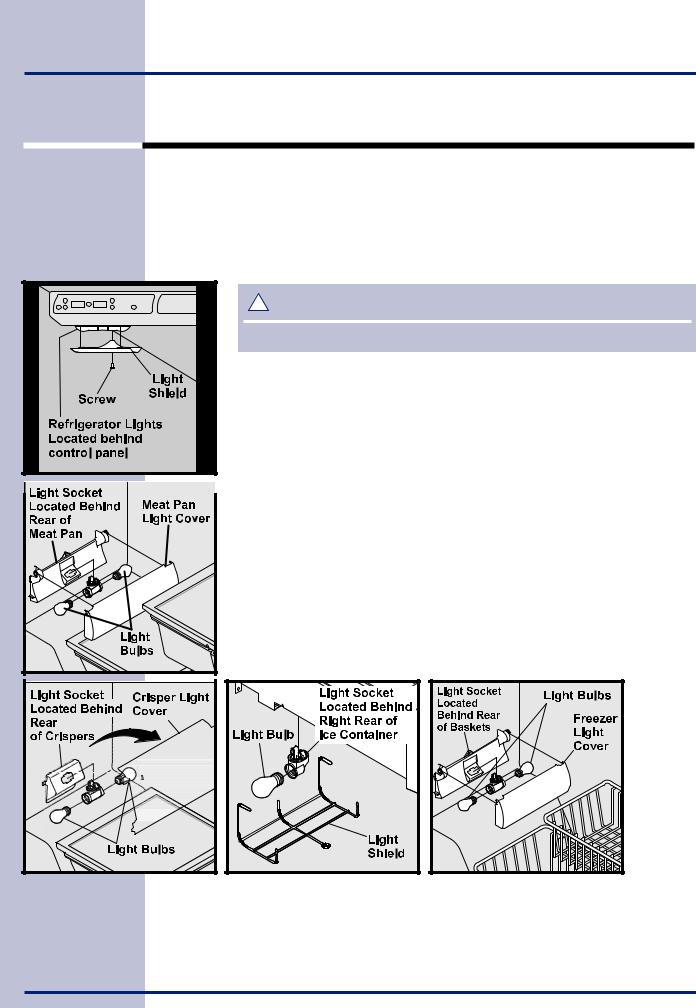
30 Care & Cleaning
REPLACING LIGHT BULBS
Both the freezer and fresh food compartments of your refrigerator include light bulbs that will need replacing from time to time. Some lights have covers that you will need to remove before replacing the bulbs. Always use bulbs that are designed for appliance lighting.
To replace light bulbs:
! CAUTION
Wear gloves when replacing light bulbs to avoid getting cut.
1 Unplug your refrigerator’s power cord.
2 Wear gloves as protection against possible broken glass.
3 Remove light cover, if necessary.
4 Unscrew and replace old bulb with an appliance bulb of the same type and wattage.
5 Replace light cover, if necessary.
6 Plug in the refrigerator’s power cord.
